Articles on St Nicholas-at-Wade church

This first article appeared in St Nicholas-At-Wade with Sarre Parish Magazine in October 1982 and shows the strength of feeling the village has for its church.
Restoration Revels
During the night of Maundy Thursday in 1975, a large 6" x 6" oak beam about 8 ft. long fell down from the roof at the back of the nave. It was found lying on the floor in the open space behind the pews when the Church was opened early on Good Friday morning. That started it. It became obvious that the roof – in fact the whole building – was in urgent need of thorough overhaul and repair.
The architect was called in, for his five-yearly inspection of the building was due anyway, and it was decided to start an appeal to raise money for the restoration. An initial target of £25,000 was agreed upon.
Through the generosity of parishioners and friends from outside the village, money soon came pouring in, enabling a start to be made. Extensive repairs were first carried out to the structure of the Nave, then the Chancel roof was completely re-tiled, and finally the Nave roof was re-slated and repairs were done to the lead roofing of the two aisles.
In 1977 the boiler chimney stack, which had become out of true and was in a dangerous condition, was re-built. In May 1978 work was started on the outside walls and on the battlements (or crenellations), some of which were so unstable and rocking on their bases as to be positively dangerous. Worn stones were replaced as necessary, and a certain amount of repainting was carried out. In that year the work was confined to the south and east fronts and the porch. In 1980, as the appeal fund had increased sufficiently, the stonework on the north side was similarly restored, with a good deal of renewal of the north-west window.
This last work was carried out with the help of a 50% grant from the Historic Buildings Council, who, having seen and inspected the church, pronounced it to be "a building of historical and architectural importance." This was their maximum grant, given to buildings of special merit.
In 1981 a new firm of architects, Purcell Miller Tritton and Partners, was appointed. It is a firm which specializes in churches and cathedrals, and, amongst other appointments, they are architects to the Diocese of Rochester and to the cathedrals of Norwich, Ely and Winchester. Their first task was to carry out the five-yearly inspection and survey. Whilst doing this they noticed that the downpipes from the gutters on the chancel roof were of a design especially favoured by a 19th century architect of the Church Commissioners. They made enquiries and discovered that the Church Commissioners were, and had been from time immemorial, the "lay rectors" of this parish, and, as such, are responsible for the upkeep of the chancel. Would that we had known this in past years! The survey was completed and the work required was carried out by St. Nicholas Builders earlier this year. Part of it was paid for by the Restoration Fund and part by the Church Commissioners!
Up to this point the work had cost almost £43,000. And there was still the west front and the tower to do, before a start could be made on the interior.
The west window of the nave was in a bad state, having been patched up with concrete in many past years. It was hoped, though, that a satisfactory restoration could be effected by cutting back the outside stonework to the glazing line and re-facing it with new stone. However, when the masons began to cut it back, it was found to be crumbling so badly that the deterioration had penetrated right through to the inside. So it was decided that the whole window must be renewed. Added to this was the complication that the old window had, over the years, become completely out of true and was no longer symmetrical. Consequently the glass also had to be remade.
All this has cost more than was anticipated, added to which the Historic Buildings Council has now reduced its maximum grant to 40%. Nevertheless, a small amount of money still remains in the Fund, and this may well be enough to carry out the greater part of the last two remaining pieces of urgent work – the renewal of the rotting timbers beneath the lead roof of the tower and turret, and the repair and pointing-up of parts of the north face of the tower.
When all this has been done we shall have spent approximately £77,000 on the structure of the church; on a restoration similar to that which was last carried out in about 1878. There remains the interior, where a certain amount of re-plastering will be necessary, as well as complete redecoration. This is estimated to cost £5,000 – £6,000, all of which will probably have to be found from church funds, as the Historic Buildings Council do not usually contribute to the costs of redecoration. It will, of course, have to wait until funds are available, but with good will and continuing perseverance it should be possible to carry this out in the next two or three years.
In the November 1983 issue of Kent Life (pp. 54-5), Roger Huntley told of an eerie experience at the village church of St Nicholas-at-Wade when the bell-ringer put his foot through the floor.
Church secret is unearthed
Something odd happened when bell-ringer Herb Bolton was replacing electric light bulbs inside St Nicholas-at-Wade parish church, near Birchington. As he went to pick up the ladder his foot went through the floor. A couple of tiles in the centre aisle had subsided, revealing a hole below. Herb called the Vicar to have a look.
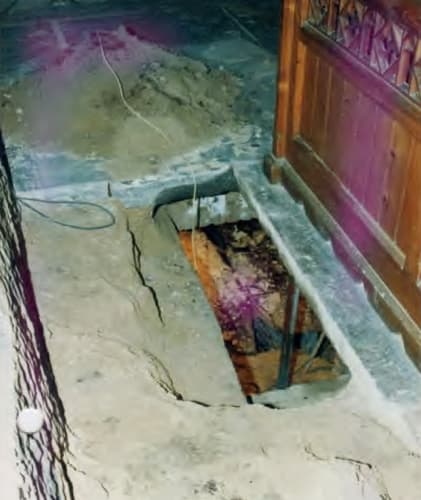
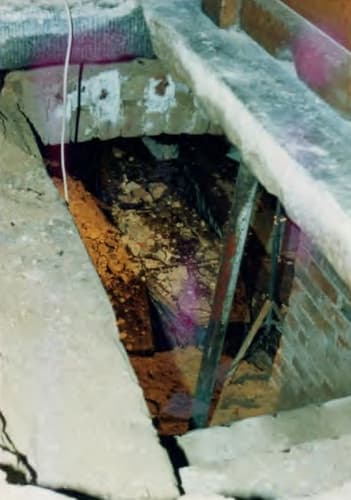
Peering down with the aid of a torch it seemed to the Rev. Owen Williams that the cavity extended further than first thought. Elsewhere, tiles also seemed to be sagging. Tapping the tiles in other parts confirmed still more hollow spots. He remembered tales about a possible old vault and passageway under the church, dating back to smuggling days of the past. There are various tales of ancient tunnels and secret passages in the village, which lies near the sea and marshes and was once flanked by the Wantsum channel on another side in the days when Thanet was a real island.
What worried the Vicar particularly, as various tiles were taken up, was the loose earth beneath. He found he could push a stick into it for a depth of several inches. "Obviously something was very wrong," he said.
Herb, the man who literally "put his foot in it" – though it is just as well he did – is foreman of the village-based St Nicholas Builders. They were called in to find out what had happened. At first it was thought that heating pipes laid under the floor a long time ago might have dried out the soil and caused the subsidence. But as they started excavating the loose soil, the secret was finally unearthed.
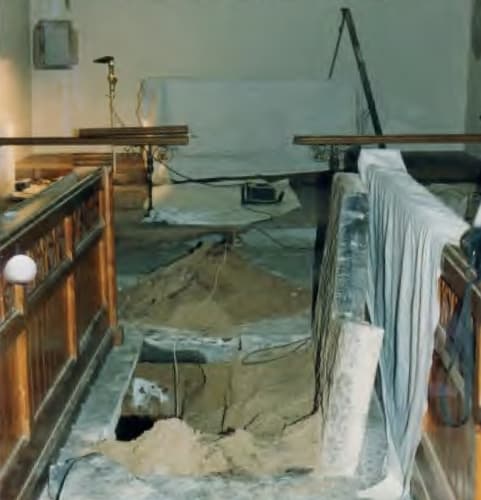
There were hundreds of human bones down there at various depths – skeletons, some still in the remnants of old elm coffins which were now crumbling to bits, others buried without coffins, wrapped in woolen shrouds. As the coffins and shrouds disintegrated the earth was falling in on them. What they had discovered was an old burial area inside the church which nobody knew about, for there were no church records.
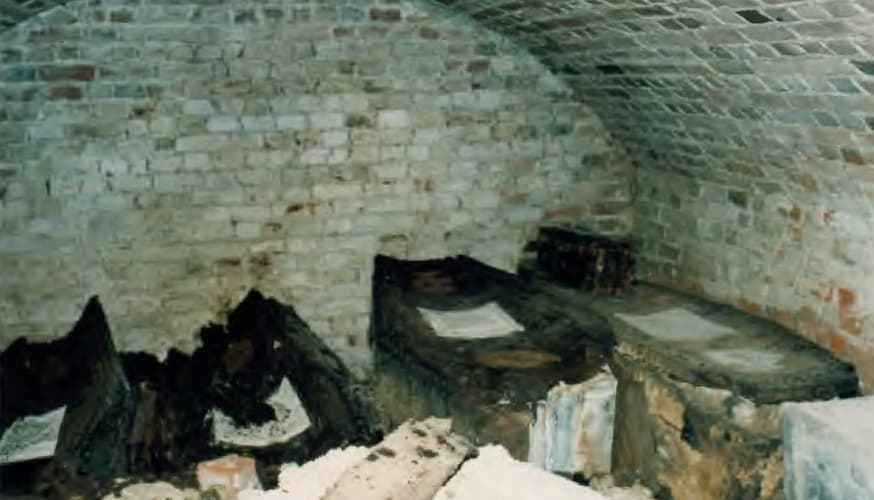
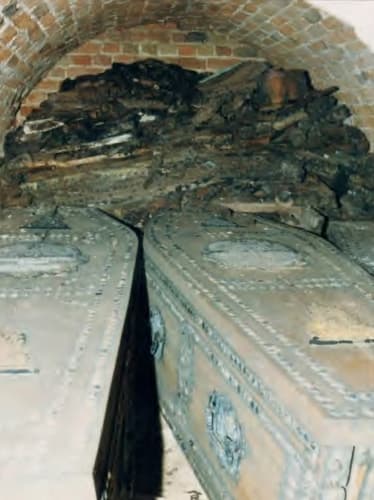
An interesting detail was that one body seemed to have been buried facing the others, indicating, the Vicar thinks, that he was a priest, "buried that way so that he would be facing his congregation on the Day of Judgment." According to the workmen another skeleton seemed to have a hole in its skull – leading to some speculation as to how the deceased met his end.
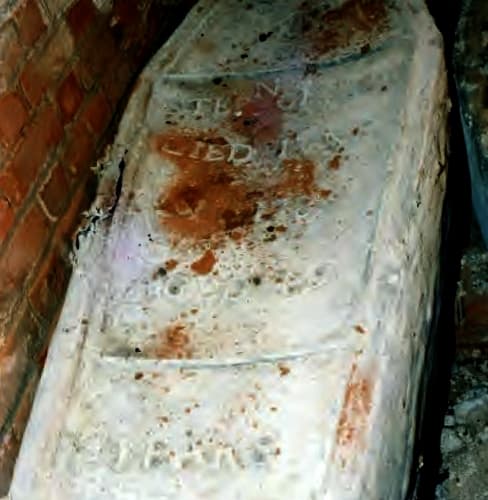
For the young workmen the task of removing the remains was an eerie experience. "It certainly wasn't very pleasant, but they did it without grumbles or complaints," said Mr Douglas Galbraith, managing director of the firm. "It was an unpleasant environment to work in." To get down to firm ground they had to excavate seven or eight feet deep in places. "We wondered where it was all going to stop," said the Vicar. A huge pile of earth was transferred to the back of the church, from where villagers and volunteers from the nearby camp site helped to take it to a dump. St Nicholas Court Farms supplied transport. This voluntary effort must have cut the cost by a couple of hundred pounds.
Eventually it was possible to put in solid foundations, the cavity was filled, and a six-inch concrete slab laid across it. Meanwhile the bones had been reinterred. Said the Vicar: "I said a prayer over them."
Under the concrete slab there is also a time capsule… a 20p coin, a postcard of the village, a parish guide and a parish magazine. "I put them in a plastic bag inside a biscuit tin which was also in a plastic bag," the Vicar told me. "Perhaps future generations may chance to come across it."
It was in January, only a few months after the Vicar's arrival in the parish, that the hole appeared. Eight months later when I visited the church, the final work of laying new tiles was ready to be done. Efforts had been made to match the old red tiles, which date back 100 years or more, as nearly as possible.
A church is thought to have existed on the site over 1,000 years, and the present building dates back in part to the 12th century. It was impossible to put a date to the burials in the centre aisle, the Vicar told me. "Probably several hundred years ago." Mr Galbraith estimated that there could have been between 15 and 20 bodies.
Throughout the repair work church services continued uninterrupted, a temporary floor being laid over the hole. Though villagers knew about it few outsiders were aware of what had happened. "We played it down," the Vicar said. They did not want to attract curious spectators, and indeed almost the only visitors were archaeologists and architects, plus the Department of the Environment, who will make a 40 per cent grant towards the cost of repairs, estimated at around £5,000.
A lady diviner was called in at an early stage when it was thought an underground passage might exist. She diagnosed "disturbed earth" in various places, her diagnosis proving remarkably accurate. The official title for what happened is now "The Hole in the Floor", and that is the name of the fund to try to foot the rest of the bill.
The fine old church, a prominent landmark in Thanet, has become expensive to maintain in recent years. Some £77,000 had already been spent on restoration work found to be necessary when a beam riddled with beetle fell from the ceiling. A further £25,000 or so needs to be spent on restoring the octagonal 14th century tower, and other places. Two village revels have raised thousands of pounds for church funds in general. At the other end of the scale, village ladies are selling home-made marmalade and one villager puts garden produce outside her gate, asking takers to contribute towards the fund.
"St Nicholas is that sort of village. The community spirit is quite remarkable," I was told. Other churches in the deanery may also help. The rural dean has sent out a letter which says "When considering the allocation of money to be given away this year, think of sending a contribution to St Nicholas-at-Wade… for help towards filling their hole."